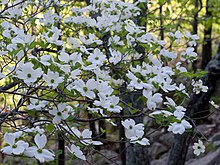Cornus florida

Cornus florida, the flowering dogwood, is a species of flowering tree in the family Cornaceae native to eastern North America and northern Mexico. An endemic population once spanned from southernmost coastal Maine south to northern Florida and west to the Mississippi River.[4] The tree is commonly planted as an ornamental in residential and public areas because of its showy bracts and interesting bark structure.
The flowering dogwood is usually included in the dogwood genus Cornus as Cornus florida L., although it is sometimes treated in a separate genus as Benthamidia florida (L.) Spach. Other old names now rarely used include American dogwood, Florida dogwood, Indian arrowwood, Cornelian tree, white cornel, white dogwood, false box, and false boxwood.
Flowering dogwood is a small deciduous tree growing to 10 m (33 ft) high, often wider than it is tall when mature, with a trunk diameter of up to 30 cm (1 ft). A 10-year-old tree will stand about 5 m (16 ft) tall. The leaves are opposite, simple, ovate, 6–13 cm (2.4–5.1 in) long and 4–6 cm (1.6–2.4 in) broad, with an apparently entire margin (actually very finely toothed, under a lens); they turn a rich red-brown in fall.
Flowering dogwood attains its greatest size and growth potential in the Upper South, sometimes up to 40 feet in height. At the northern end of its range, heights of 30–33 feet are more typical. Hot, humid summer weather is necessary for new growth to harden off in the fall.
The maximum lifespan of C. florida is about 80 years.[5]
The flowers are individually small and inconspicuous, with four greenish-yellow bracts 4 mm (0.16 in) long. Around 20 flowers are produced in a dense, rounded, umbel-shaped inflorescence, or flower-head, 1–2 cm (0.39–0.79 in) in diameter. The flower-head is surrounded by four conspicuous large white, pink or red “petals” (actually bracts), each bract 3 cm (1.2 in) long and 2.5 cm (0.98 in) broad, rounded, and often with a distinct notch at the apex. The flowers are hermaphroditic (“perfect flowers”) .
When in the wild they can typically be found at the forest edge and frequently on dry ridges. While most of the wild trees have white bracts, some selected cultivars of this tree also have pink bracts, some even almost a true red. They typically flower in early April in the southern part of their range, to late April or early May in northern and high altitude areas. The similar Kousa dogwood (Cornus kousa), native to Asia, flowers about a month later.
The fruit is a cluster of two to ten separate drupes, (fused in Cornus kousa), each 10–15 mm (0.39–0.59 in) long and about 8 mm (0.31 in) wide, which ripen in the late summer and the early fall to a bright red, or occasionally yellow with a rosy blush. They are an important food source for dozens of species of birds, which then distribute the seeds. They are also a larval host plant for several moth varieties, including Eudeilinia herminiata, the dogwood thyatirid moth, Antispila cornifoliella, the stinging rose moth, the grand arches moth,[6] the pecan bark borer,[7] the dogwood borer,[8] the rosaceaous leaf roller, the diamondback epinotia moth, spring azures,[9] cecropia moths,[10] and the Io moth. While not poisonous to humans, the fruit is extremely sour and unpleasant-tasting. Flowering dogwood is monoecious, meaning the tree has both male and female flowers, and all trees will produce fruit.
